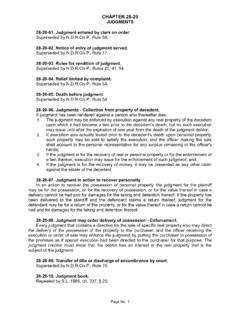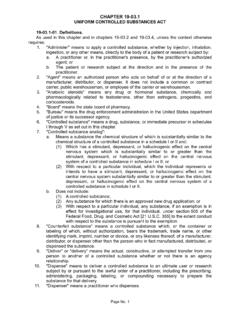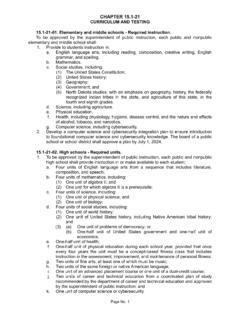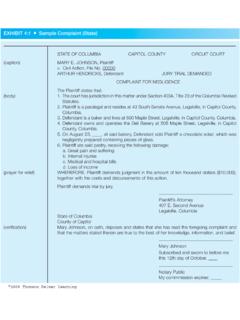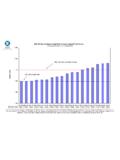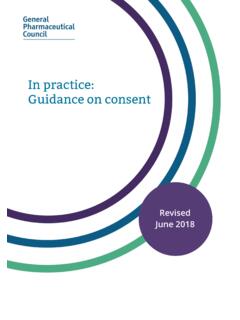Transcription of CHAPTER 39-20 CHEMICAL TEST FOR INTOXICATION, …
1 CHAPTER 39-20 . CHEMICAL TEST FOR INTOXICATION, implied CONSENT. 39-20 -01. implied consent to determine alcohol concentration and presence of drugs. 1. Any individual who operates a motor vehicle on a highway or on public or private areas to which the public has a right of access for vehicular use in this state is deemed to have given consent, and shall consent, subject to the provisions of this CHAPTER , to a CHEMICAL test, or tests, of the blood, breath, oral fluid, or urine for the purpose of determining the alcohol concentration or presence of other drugs, or combination thereof, in the individual's blood, breath, oral fluid, or urine. As used in this CHAPTER , the word "drug" means any drug or substance or combination of drugs or substances which renders an individual incapable of safely driving, and the words " CHEMICAL test".
2 Or " CHEMICAL analysis" mean any test to determine the alcohol concentration or presence of other drugs, or combination thereof, in the individual's blood, breath, or urine, approved by the director of the state crime laboratory or the director's designee under this CHAPTER . 2. The test or tests must be administered at the direction of a law enforcement officer only after placing the individual under arrest for violation of section 39-08-01 or an equivalent offense. For the purposes of this CHAPTER , the taking into custody of a child under section or an individual under twenty-one years of age satisfies the requirement of an arrest. The law enforcement officer shall determine which of the tests is to be used. 3. a. The law enforcement officer shall inform the individual North Dakota law requires the individual to take a CHEMICAL test to determine whether the individual is under the influence of alcohol or drugs and refusal of the individual to submit to a test directed by the law enforcement officer may result in a revocation of the individual's driving privileges for a minimum of one hundred eighty days and up to three years.
3 B. If an individual refuses to submit to testing under this section, proof of the refusal is not admissible in any administrative proceeding under this CHAPTER if the law enforcement officer fails to inform the individual as required under subdivision a. 4. When an individual under the age of eighteen years is taken into custody for violating section 39-08-01 or an equivalent ordinance, the law enforcement officer shall attempt to contact the individual's parent or legal guardian to explain the cause for the custody. Neither the law enforcement officer's efforts to contact, nor any consultation with, a parent or legal guardian may be permitted to interfere with the administration of CHEMICAL testing requirements under this CHAPTER . The law enforcement officer shall mail a notice to the parent or legal guardian of the minor within ten days after the test results are received or within ten days after the minor is taken into custody if the minor refuses to submit to testing.
4 The notice must contain a statement of the test performed and the results of that test; or if the minor refuses to submit to the testing, a statement notifying of that fact. The attempt to contact or the contacting or notification of a parent or legal guardian is not a precondition to the admissibility of CHEMICAL test results or the finding of a consent to, or refusal of, CHEMICAL testing by the individual in custody. CHEMICAL test of driver in serious bodily injury or fatal crashes. 1. If the driver of a vehicle is involved in a crash resulting in the death of another individual, and there is probable cause to believe that the driver is in violation of section 39-08-01, a law enforcement officer shall request the driver to submit to a CHEMICAL test or tests of the driver's blood, breath, or urine to determine the alcohol concentration or the presence of other drugs or substances, or both.
5 2. If the driver of a vehicle is involved in a crash resulting in the serious bodily injury, as defined in section , of another individual, and there is probable cause to believe that the driver is in violation of section 39-08-01, a law enforcement officer shall request the driver to submit to a test or tests of the driver's blood, breath, or urine Page No. 1. to determine the alcohol concentration or the presence of other drugs or substances, or both. 3. If the driver refuses to submit to a CHEMICAL test or tests of the driver's blood, breath, or urine and exigent circumstances are not present, the law enforcement officer shall request a search warrant to compel the driver to submit to a CHEMICAL test or tests of the driver's blood, breath, or urine to determine the alcohol concentration or the presence of other drugs or substances, or both.
6 4. The approved methods of the director of the state crime laboratory or the director's designee must be followed in collecting and preserving a sample of the driver's blood, breath, or urine and conducting a CHEMICAL test or tests to determine the alcohol concentration or the presence of other drugs or substances, or both. 39-20 -02. Individuals qualified to administer test and opportunity for additional test. Only an individual medically qualified to draw blood, acting at the request of a law enforcement officer, may withdraw blood for the purpose of determining the alcohol concentration or presence of other drugs, or combination thereof, in the individual's blood. The director of the state crime laboratory or the director's designee shall determine the qualifications or credentials for being medically qualified to draw blood, and shall issue a list of approved designations including medical doctor and registered nurse.
7 This limitation does not apply to the taking of a breath or urine specimen. The director of the state crime laboratory, or the director's designee, shall electronically post a copy of the certified list of approved designations, including medical doctor and registered nurse, with the state crime laboratory division of the attorney general at the attorney general website and shall make the certified records required by this section available for download in a printable format on the attorney general website. The individual tested may have an individual of the individual's choosing, who is medically qualified to draw blood, administer a CHEMICAL test or tests in addition to any administered at the direction of a law enforcement officer with all costs of an additional test or tests to be the sole responsibility of the individual charged.
8 The failure or inability to obtain an additional test by an individual does not preclude the admission of the test or tests taken at the direction of a law enforcement officer. Upon the request of the individual who is tested, a copy of the operational checklist and test record of a breath sample test or analytical report of a blood or urine sample test taken at the direction of the law enforcement officer must be made available to that individual by the law enforcement agency that administered the test or tests. 39-20 -03. Consent of person incapable of refusal not withdrawn. Repealed by 2017, ch. 268, 9. Action following test result for a resident operator. If a person submits to a test under section 39-20 -01 or 39-20 -02 and the test shows that person to have an alcohol concentration of at least eight one-hundredths of one percent by weight or, with respect to a person under twenty-one years of age, an alcohol concentration of at least two one-hundredths of one percent by weight at the time of the performance of a CHEMICAL test within two hours after the driving or being in actual physical control of a vehicle, the following procedures apply: 1.
9 The law enforcement officer shall immediately issue to that person a temporary operator's permit if the person then has valid operating privileges, extending driving privileges for the next twenty-five days, or until earlier terminated by the decision of a hearing officer under section 39-20 -05. The law enforcement officer shall sign and note the date on the temporary operator's permit. The temporary operator's permit serves as the director's official notification to the person of the director's intent to revoke, suspend, or deny driving privileges in this state. 2. If a test administered under section 39-20 -01 was by urine sample or by drawing blood as provided in section 39-20 -02 and the individual tested is not a resident of an area in which the law enforcement officer has jurisdiction, the law enforcement officer shall, on receiving the analysis of the urine or blood from the director of the state crime Page No.
10 2. laboratory or the director's designee and if the analysis shows that individual had an alcohol concentration of at least eight one-hundredths of one percent by weight or, with respect to an individual under twenty-one years of age, an alcohol concentration of at least two one-hundredths of one percent by weight, either proceed in accordance with subsection 1 during that individual's reappearance within the officer's jurisdiction, proceed in accordance with subsection 3, or notify a law enforcement agency having jurisdiction where the individual lives. On that notification, that law enforcement agency shall, within twenty-four hours, forward a copy of the temporary operator's permit to the law enforcement agency making the arrest or to the director. The law enforcement agency shall issue to that individual a temporary operator's permit as provided in this section, and shall sign and date the permit as provided in subsection 1.
